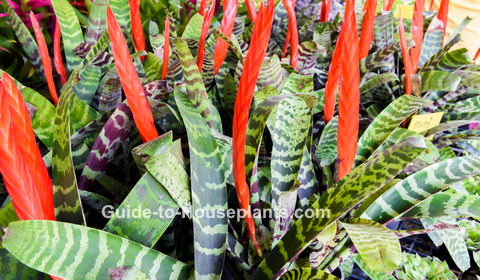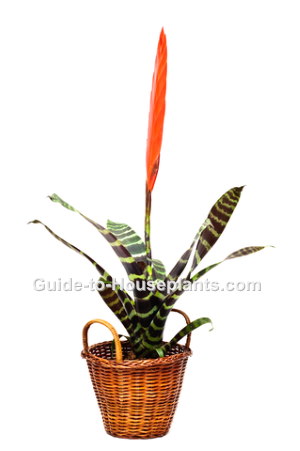How to Grow Vriesea Splendens
Botanical Name: Vriesea splendens
Native to the tropical South American rainforests, this showy member of the Bromeliaceae family will adapt to your home...if you know how to treat it. Give this exotic beauty warm temperatures, bright sunlight, plenty of humidity, and it'll feel right at home.
 Wildly patterned foliage is upstaged only by bright red flower spikes.
Wildly patterned foliage is upstaged only by bright red flower spikes.What to Know About Your Vriesea Splendens
Repot every couple years just to refresh the potting medium. Bromeliad or orchid mixes are made of fir bark, which breaks down and becomes compact after a while. You want the potting medium loose around this native tree-dweller so don't pack it down.
No bloom? Bromes that don't bloom may just be too young; only mature plants will bloom. It may not getting enough light. Also feed it regularly during the growing season. Phosphorus in fertilizers give flowering plants more oomph. This tropical beauty can flower almost any time of year when it's ready.
What to do after the bloom. Vriesea will flower once, then slowly die. You can expect your plant to live about 3 to 4 years. But if you pot up its offsets, called "pups" you'll enjoy a succession of bromes... possibly indefinitely. Bromeliads are plants that keep on giving. You'll wait for those spectacular flower spikes, though, so be patient. Those pups won't bloom until they're a couple years old.
Something bugging your plant? Dry conditions can attract red spider mites to houseplants. You'll first notice webbing between the leaves. Spider mites are so tiny, they just look like specks on the web. Treat any infestation immediately, because these destructive critters will damage your plant and may move on to your other houseplants. One way to prevent them is to keep the humidity high around your plant, especially in winter.
Buying Tips
Today there are countless hybrids available. Most are bred for larger flowers, making them more appealing to grow as houseplants. Although red is the most common, some cultivars have yellow bracts. Other Vriesea species are available, but they don't have variegated foliage like this one.
Once hard to find, more garden centers and florist shops are stocking V. splendens in the spring and summer. Look for a plant with a flower spike that's barely emerging from the rosette of leaves, so you can watch it grow and bloom.
Vriesea Splendens Care

Origin: South America
Height: About 18 in (45 cm)
Light: Put Vriesea splendens in a bright location out of direct sun. Hot summer sun exposure can cause brown scorched spots on foliage.
Water: Water the center of the rosette and keep 1 in (2.5 cm) of room-temperature rainwater or distilled water in its rosette at all times. Water potting medium just enough to keep the roots barely moist. Always use tepid water when watering your houseplants; cold water is a shock to them.
Humidity: Maintain high (at least 50% relative humidity) around V. splendens. Humidity in a home can drop drastically in winter, so it's a good idea to use a humidity gauge rather than guess. Short of turning your home into a misty rain forest, there are a few easy ways to raise the humidity around your tropical plants.
Temperature: Warm (70-80°F/21-27°C) room temperatures year-round. Don't expose it to temps below 50°F/10°C. Keep your Bromeliad away from the hot, drying drafts from heat vents as well as cold winter blasts from windows and doors, and AC vents.
Potting Medium: Bromeliads don't like heavy potting soil, which holds too much water and can lead to root rot. Use medium-grade bromeliad or orchid potting mix. This special fir bark mix will keep moisture around its roots, while still allowing air around them.
Fertilizer: Feed monthly spring through summer with a balanced liquid or water-soluble fertilizer mixed at half strength.
Propagation: Cut off the offsets (pups) that grow around the plant when they are at least 8 in (20 cm) tall and pot them in fresh, barely moist potting mix.


